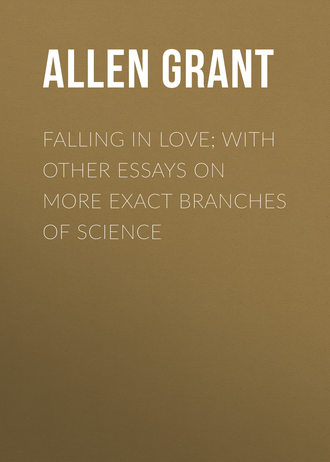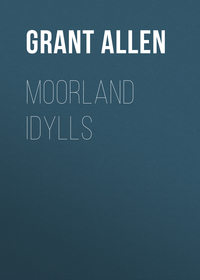 полная версия
полная версияFalling in Love; With Other Essays on More Exact Branches of Science
Erasmus Darwin, the grandfather of his grandson, was no fool; on the contrary, he was the most far-sighted man of his day in England; he saw at once what Buffon was driving at; and he worked out 'Mr. Buffon's' half-concealed hint to all its natural and legitimate conclusions. The great Count was always plain Mr. Buffon to his English contemporary. Life, said Erasmus Darwin nearly a century since, began in very minute marine forms, which gradually acquired fresh powers and larger bodies, so as imperceptibly to transform themselves into different creatures. Man, he remarked, anticipating his descendant, takes rabbits or pigeons, and alters them almost to his own fancy, by immensely changing their shapes and colours. If man can make a pouter or a fantail out of the common runt, if he can produce a piebald lop-ear from the brown wild rabbit, if he can transform Dorkings into Black Spanish, why cannot Nature, with longer time to work in, and endless lives to try with, produce all the varieties of vertebrate animals out of one single common ancestor? It was a bold idea of the Lichfield doctor—bold, at least, for the times he lived in—when Sam Johnson was held a mighty sage, and physical speculation was regarded askance as having in it a dangerous touch of the devil. But the Darwins were always a bold folk, and had the courage of their opinions more than most men. So even in Lichfield, cathedral city as it was, and in the politely somnolent eighteenth century, Erasmus Darwin ventured to point out the probability that quadrupeds, birds, reptiles, and men were all mere divergent descendants of a single similar original form, and even that 'one and the same kind of living filament is, and has been, the cause of organic life.'
The eighteenth century laughed, of course. It always laughed at all reformers. It said Dr. Darwin was very clever, but really a most eccentric man. His 'Temple of Nature,' now, and his 'Botanic Garden,' were vastly fine and charming poems—those sweet lines, you know, about poor Eliza!—but his zoological theories were built of course upon a most absurd and uncertain foundation. In prose, no sensible person could ever take the doctor seriously. A freak of genius—nothing more; a mere desire to seem clever and singular. But what a Nemesis the whirligig of time has brought around with it! By a strange irony of fate, those admired verses are now almost entirely forgotten; poor Eliza has survived only as our awful example of artificial pathos; and the zoological heresies, at which the eighteenth century shrugged its fat shoulders and dimpled the corners of its ample mouth, have grown to be the chief cornerstone of all accepted modern zoological science.
In the first year of the present century, Lamarck followed Erasmus Darwin's lead with an open avowal that in his belief all animals and plants were really descended from one or a few common ancestors. He held that organisms were just as much the result of law, not of miraculous interposition, as suns and worlds and all the natural phenomena around us generally. He saw that what naturalists call a species differs from what naturalists call a variety, merely in the way of being a little more distinctly marked, a little less like its nearest congeners elsewhere. He recognised the perfect gradation of forms by which in many cases one species after another merges into the next on either side of it. He observed the analogy between the modifications induced by man and the modifications induced by nature. In fact, he was a thorough-going and convinced evolutionist, holding every salient opinion which Society still believes to have been due to the works of Charles Darwin. In one point only, a minor point to outsiders, though a point of cardinal importance to the inner brotherhood of evolutionism, he did not anticipate his more famous successor. He thought organic evolution was wholly due to the direct action of surrounding circumstances, to the intercrossing of existing forms, and above all to the actual efforts of animals themselves. In other words, he had not discovered natural selection, the cardinal idea of Charles Darwin's epoch-making book. For him, the giraffe had acquired its long neck by constant reaching up to the boughs of trees; the monkey had acquired its opposable thumb by constant grasping at the neighbouring branches; and the serpent had acquired its sinuous shape by constant wriggling through the grass of the meadows. Charles Darwin improved upon all that by his suggestive hint of survival of the fittest, and in so far, but in so far alone, he became the real father of modern biological evolutionism.
From the days of Lamarck, to the day when Charles Darwin himself published his wonderful 'Origin of Species,' this idea that plants and animals might really have grown, instead of having been made all of a piece, kept brewing everywhere in the minds and brains of scientific thinkers. The notions which to the outside public were startlingly new when Darwin's book took the world by storm, were old indeed to the thinkers and workers who had long been familiar with the principle of descent with modification and the speculations of the Lichfield doctor or the Paris philosopher. Long before Darwin wrote his great work, Herbert Spencer had put forth in plain language every idea which the drawing-room biologists attributed to Darwin. The supporters of the development hypothesis, he said seven years earlier—yes, he called it the 'development hypothesis' in so many words—'can show that modification has effected and is effecting great changes in all organisms, subject to modifying influences.' They can show, he goes on (if I may venture to condense so great a thinker), that any existing plant or animal, placed under new conditions, begins to undergo adaptive changes of form and structure; that in successive generations these changes continue, till the plant or animal acquires totally new habits; that in cultivated plants and domesticated animals changes of the sort habitually occur; that the differences thus caused, as for example in dogs, are often greater than those on which species in the wild state are founded, and that throughout all organic nature there is at work a modifying influence of the same sort as that which they believed to have caused the differences of species—'an influence which, to all appearance, would produce in the millions of years and under the great variety of conditions which geological records imply, any amount of change.' What is this but pure Darwinism, as the drawing-room philosopher still understands the word? And yet it was written seven years before Darwin published the 'Origin of Species.'
The fact is, one might draw up quite a long list of Darwinians before Darwin. Here are a few of them—Buffon, Lamarck, Goethe, Oken, Bates, Wallace, Lecoq, Von Baer, Robert Chambers, Matthew, and Herbert Spencer. Depend upon it, no one man ever yet of himself discovered anything. As well say that Luther made the German Reformation, that Lionardo made the Italian Renaissance, or that Robespierre made the French Revolution, as say that Charles Darwin, and Charles Darwin alone, made the evolutionary movement, even in the restricted field of life only. A thousand predecessors worked up towards him; a thousand contemporaries helped to diffuse and to confirm his various principles.
Charles Darwin added to the primitive evolutionary idea the special notion of natural selection. That is to say, he pointed out that while plants and animals vary perpetually and vary indefinitely, all the varieties so produced are not equally adapted to the circumstances of the species. If the variation is a bad one, it tends to die out, because every point of disadvantage tells against the individual in the struggle for life. If the variation is a good one, it tends to persist, because every point of advantage similarly tells in the individual's favour in that ceaseless and viewless battle. It was this addition to the evolutionary concept, fortified by Darwin's powerful advocacy of the general principle of descent with modification, that won over the whole world to the 'Darwinian theory.' Before Darwin, many men of science were evolutionists: after Darwin, all men of science became so at once, and the rest of the world is rapidly preparing to follow their leadership.
As applied to life, then, the evolutionary idea is briefly this—that plants and animals have all a natural origin from a single primitive living creature, which itself was the product of light and heat acting on the special chemical constituents of an ancient ocean. Starting from that single early form, they have gone on developing ever since, from the homogeneous to the heterogeneous, assuming ever more varied shapes, till at last they have reached their present enormous variety of tree, and shrub, and herb, and seaweed, of beast, and bird, and fish, and creeping insect. Evolution throughout has been one and continuous, from nebula to sun, from gas-cloud to planet, from early jelly-speck to man or elephant. So at least evolutionists say—and of course they ought to know most about it.
But evolution, according to the evolutionists, does not even stop here. Psychology as well as biology has also its evolutionary explanation: mind is concerned as truly as matter. If the bodies of animals are evolved, their minds must be evolved likewise. Herbert Spencer and his followers have been mainly instrumental in elucidating this aspect of the case. They have shown, or they have tried to show (for I don't want to dogmatise on the subject), how mind is gradually built up from the simplest raw elements of sense and feeling; how emotions and intellect slowly arise; how the action of the environment on the organism begets a nervous system of ever greater and greater complexity, culminating at last in the brain of a Newton, a Shakespeare, or a Mendelssohn. Step by step, nerves have built themselves up out of the soft tissues as channels of communication between part and part. Sense-organs of extreme simplicity have first been formed on the outside of the body, where it comes most into contact with external nature. Use and wont have fashioned them through long ages into organs of taste and smell and touch; pigment spots, sensitive to light or shade, have grown by infinite gradations into the human eye or into the myriad facets of bee and beetle; tremulous nerve-ends, responsive sympathetically to waves of sound, have tuned themselves at last into a perfect gamut in the developed ear of men and mammals. Meanwhile corresponding percipient centres have grown up in the brain, so that the coloured picture flashed by an external scene upon the eye is telegraphed from the sensitive mirror of the retina, through the many-stranded cable of the optic nerve, straight up to the appropriate headquarters in the thinking brain. Stage by stage the continuous process has gone on unceasingly, from the jelly-fish with its tiny black specks of eyes, through infinite steps of progression, induced by ever-widening intercourse with the outer world, to the final outcome in the senses and the emotions, the intellect and the will, of civilised man. Mind begins as a vague consciousness of touch or pressure on the part of some primitive, shapeless, soft creature: it ends as an organised and co-ordinated reflection of the entire physical and psychical universe on the part of a great cosmical philosopher.
Last of all, like diners-out at dessert, the evolutionists take to politics. Having shown us entirely to their own satisfaction the growth of suns, and systems, and worlds, and continents, and oceans, and plants, and animals, and minds, they proceed to show us the exactly analogous and parallel growth of communities, and nations, and languages, and religions, and customs, and arts, and institutions, and literatures. Man, the evolving savage, as Tylor, Lubbock, and others have proved for us, slowly putting off his brute aspect derived from his early ape-like ancestors, learned by infinitesimal degrees the use of fire, the mode of manufacturing stone hatchets and flint arrowheads, the earliest beginnings of the art of pottery. With drill or flint he became the Prometheus to his own small heap of sticks and dry leaves among the tertiary forests. By his nightly camp-fire he beat out gradually his excited gesture-language and his oral speech. He tamed the dog, the horse, the cow, the camel. He taught himself to hew small clearings in the woodland, and to plant the banana, the yam, the bread-fruit, and the coco-nut. He picked and improved the seeds of his wild cereals till he made himself from grass-like grains his barley, his oats, his wheat, his Indian corn. In time, he dug out ore from mines, and learnt the use first of gold, next of silver, then of copper, tin, bronze, and iron. Side by side with these long secular changes, he evolved the family, communal or patriarchal, polygamic or monogamous. He built the hut, the house, and the palace. He clothed or adorned himself first in skins and leaves and feathers; next in woven wool and fibre; last of all in purple and fine linen, and fared sumptuously every day. He gathered into hordes, tribes, and nations; he chose himself a king, gave himself laws, and built up great empires in Egypt, Assyria, China, and Peru. He raised him altars, Stonehenges and Karnaks. His picture-writing grew into hieroglyphs and cuneiforms, and finally emerged, by imperceptible steps, into alphabetic symbols, the raw material of the art of printing. His dug-out canoe culminates in the iron-clad and the 'Great Eastern'; his boomerang and slingstone in the Woolwich infant; his boiling pipkin and his wheeled car in the locomotive engine; his picture-message in the telephone and the Atlantic cable. Here, where the course of evolution has really been most marvellous, its steps have been all more distinctly historical; so that nobody now doubts the true descent of Italian, French, and Spanish from provincial Latin, or the successive growth of the trireme, the 'Great Harry,' the 'Victory,' and the 'Minotaur' from the coracles or praus of prehistoric antiquity.
The grand conception of the uniform origin and development of all things, earthly or sidereal, thus summed up for us in the one word evolution, belongs by right neither to Charles Darwin nor to any other single thinker. It is the joint product of innumerable workers, all working up, though some of them unconsciously, towards a grand final unified philosophy of the cosmos. In astronomy, Kant, Laplace, and the Herschels; in geology, Hutton, Lyell, and the Geikies; in biology, Buffon, Lamarck, the Darwins, Huxley, and Spencer; in psychology, Spencer, Romanes, Sully, and Ribot; in sociology, Spencer, Tylor, Lubbock, and De Mortillet—these have been the chief evolutionary teachers and discoverers. But the use of the word evolution itself, and the establishment of the general evolutionary theory as a system of philosophy applicable to the entire universe, we owe to one man alone—Herbert Spencer. Many other minds—from Galileo and Copernicus, from Kepler and Newton, from Linnæus and Tournefort, from D'Alembert and Diderot, nay, even, in a sense, from Aristotle and Lucretius—had been piling together the vast collection of raw material from which that great and stately superstructure was to be finally edified. But the architect who placed each block in its proper niche, who planned and designed the whole elevation, who planted the building firmly on the rock and poised the coping-stone on the topmost pinnacle, was the author of the 'System of Synthetic Philosophy,' and none other. It is a strange proof of how little people know about their own ideas, that among the thousands who talk glibly every day of evolution, not ten per cent. are probably aware that both word and conception are alike due to the commanding intelligence and vast generalising power of Herbert Spencer.
STRICTLY INCOG
Among the reefs of rock upon the Australian coast, an explorer's dredge often brings up to the surface some tangled tresses of reddish seaweed, which, when placed for a while in a bucket of water, begin slowly to uncoil themselves as if endowed with animal life, and finally to swim about with a gentle tremulous motion in a mute inquiring way from side to side of the pail that contains them. Looked at closely with an attentive eye, the complex moving mass gradually resolves itself into two parts: one a ruddy seaweed with long streaming fronds; the other, a strangely misshapen and dishevelled pipe-fish, exactly imitating the weed itself in form and colour. When removed from the water, this queer pipe-fish proves in general outline somewhat to resemble the well-known hippocampus or sea-horse of the aquariums, whose dried remains, in a mummified state, form a standing wonder in many tiny domestic museums. But the Australian species, instead of merely mimicking the knight on a chess-board, looks rather like a hippocampus in the most advanced stage of lunacy, with its tail and fins and the appendages of its spines flattened out into long thin streaming filaments, utterly indistinguishable in hue and shape from the fucus round which the creature clings for support with its prehensile tail. Only a rude and shapeless rough draught of a head, vaguely horse-like in contour, and inconspicuously provided with an unobtrusive snout and a pair of very unnoticeable eyes, at all suggests to the most microscopic observer its animal nature. Taken as a whole, nobody could at first sight distinguish it in any way from the waving weed among which it vegetates.
Clearly, this curious Australian cousin of the Mediterranean sea-horses has acquired so marvellous a resemblance to a bit of fucus in order to deceive the eyes of its ever-watchful enemies, and to become indistinguishable from the uneatable weed whose colour and form it so surprisingly imitates. Protective resemblances of the sort are extremely common among the pipe-fish family, and the reason why they should be so is no doubt sufficiently obvious at first sight to any reflecting mind—such, for example, as the intelligent reader's. Pipe-fish, as everybody knows, are far from giddy. They do not swim in the vortex of piscine dissipation. Being mostly small and defenceless creatures, lurking among the marine vegetation of the shoals and reefs, they are usually accustomed to cling for support by their snake-like tails to the stalks or leaves of those submerged forests. The omniscient schoolboy must often have watched in aquariums the habits and manners of the common sea-horses, twisted together by their long thin bodies into one inextricable mass of living matwork, or anchored firmly with a treble serpentine coil to some projecting branch of coralline or of quivering sea-wrack. Bad swimmers by nature, utterly unarmed, and wholly undefended by protective mail, the pipe-fish generally can neither fight nor run away: and therefore they depend entirely for their lives upon their peculiar skulking and lurking habits. Their one mode of defence is not to show themselves; discretion is the better part of their valour; they hide as much as possible among the thickest seaweed, and trust to Providence to escape observation.
Now, with any animals thus constituted, cowards by hereditary predilection, it must necessarily happen that the more brightly coloured or obtrusive individuals will most readily be spotted and most unceremoniously devoured by their sharp-sighted foes, the predatory fishes. On the other hand, just in proportion as any particular pipe-fish happens to display any chance resemblance in colour or appearance to the special seaweed in whose folds it lurks, to that extent will it be likely to escape detection, and to hand on its peculiarities to its future descendants. A long-continued course of the simple process thus roughly described must of necessity result at last in the elimination of all the most conspicuous pipe-fish, and the survival of all those unobtrusive and retiring individuals which in any respect happen to resemble the fucus or coralline among which they dwell. Hence, in many places, various kinds of pipe-fish exhibit an extraordinary amount of imitative likeness to the sargasso or seaweed to whose tags they cling; and in the three most highly developed Australian species the likeness becomes so ridiculously close that it is with difficulty one can persuade oneself one is really and truly looking at a fish, and not at a piece of strangely animated and locomotive fucus.
Of course, the playful pipe-fish is by no means alone in his assumption of so neat and effective a disguise. Protective resemblances of just the same sort as that thus exhibited by this extraordinary little creature are common throughout the whole range of nature; instances are to be found in abundance, not only among beasts, birds, reptiles, and fishes, but even among caterpillars, butterflies, and spiders, of species which preserve the strictest incognito. Everywhere in the world, animals and plants are perpetually masquerading in various assumed characters; and sometimes their make-up is so exceedingly good as to take in for a while not merely the uninstructed ordinary observer, but even the scientific and systematic naturalist.
A few selected instances of such successful masquerading will perhaps best serve to introduce the general principles upon which all animal mimicry ultimately depends. Indeed, naturalists of late years have been largely employed in fishing up examples from the ends of the earth and from the depths of the sea for the elucidation of this very subject. There is a certain butterfly in the islands of the Malay Archipelago (its learned name, if anybody wishes to be formally introduced, is Kallima paralekta) which always rests among dead or dry leaves, and has itself leaf-like wings, all spotted over at intervals with wee speckles to imitate the tiny spots of fungi on the foliage it resembles. The well-known stick and leaf insects from the same rich neighbourhood in like manner exactly mimic the twigs and leaves of the forest among which they lurk: some of them look for all the world like little bits of walking bamboo, while others appear in all varieties of hue, as if opening buds and full-blown leaves and pieces of yellow foliage sprinkled with the tints and moulds of decay had of a sudden raised themselves erect upon six legs, and begun incontinently to perambulate the Malayan woodlands like vegetable Frankensteins in all their glory. The larva of one such deceptive insect, observed in Nicaragua by sharp-eyed Mr. Belt, appeared at first sight like a mere fragment of the moss on which it rested, its body being all prolonged into little thread-like green filaments, precisely imitating the foliage around it. Once more, there are common flies which secure protection for themselves by growing into the counterfeit presentment of wasps or hornets, and so obtaining immunity from the attacks of birds or animals. Many of these curiously mimetic insects are banded with yellow and black in the very image of their stinging originals, and have their tails sharpened, in terrorem, into a pretended sting, to give point and verisimilitude to the deceptive resemblance. More curious still, certain South American butterflies of a perfectly inoffensive and edible family mimic in every spot and line of colour sundry other butterflies of an utterly unrelated and fundamentally dissimilar type, but of so disagreeable a taste as never to be eaten by birds or lizards. The origin of these curious resemblances I shall endeavour to explain (after Messrs. Bates and Wallace) a little farther on: for the present it is enough to observe that the extraordinary resemblances thus produced have often deceived the very elect, and have caused experienced naturalists for a time to stick some deceptive specimen of a fly among the wasps and hornets, or some masquerading cricket into the midst of a cabinet full of saw-flies or ichneumons.
Let us look briefly at the other instances of protective coloration in nature generally which lead up to these final bizarre exemplifications of the masquerading tendency.
Wherever all the world around is remarkably uniform in colour and appearance, all the animals, birds, and insects alike necessarily disguise themselves in its prevailing tint to escape observation. It does not matter in the least whether they are predatory or defenceless, the hunters or the hunted: if they are to escape destruction or starvation, as the case may be, they must assume the hue of all the rest of nature about them. In the arctic snows, for example, all animals, without exception, must needs be snow-white. The polar bear, if he were brown or black, would immediately be observed among the unvaried ice-fields by his expected prey, and could never get a chance of approaching his quarry unperceived at close quarters. On the other hand, the arctic hare must equally be dressed in a snow-white coat, or the arctic fox would too readily discover him and pounce down upon him off-hand; while, conversely, the fox himself, if red or brown, could never creep upon the unwary hare without previous detection, which would defeat his purpose. For this reason, the ptarmigan and the willow grouse become as white in winter as the vast snow-fields under which they burrow; the ermine changes his dusky summer coat for the expensive wintry suit beloved of British Themis; the snow-bunting acquires his milk-white plumage; and even the weasel assimilates himself more or less in hue to the unvarying garb of arctic nature. To be out of the fashion is there quite literally to be out of the world: no half-measures will suit the stern decree of polar biology; strict compliance with the law of winter change is absolutely necessary to success in the struggle for existence.









